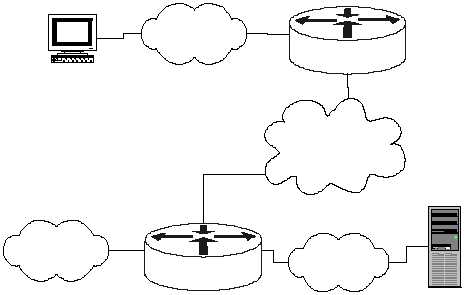
index_7
UNCLASSIFIED
Introduction
Version 1.0g
UNCLASSIFIED
7
1. Introduction
1.1. The Roles of Routers in Modern Networks
On a very small computer network, it is feasible to use simple broadcast or sequential
mechanisms for moving data from point to point. An Ethernet local area network
(LAN) is essentially a broadcast network. In larger, more complex computer
networks, data must be directed specifically to the intended destination. Routers
direct network data messages, or packets, based on internal addresses and tables of
routes, or known destinations that serve certain addresses. Directing data between
portions of a network is the primary purpose of a router.
Most large computer networks use the TCP/IP protocol suite. See Section 2.3 for a
quick review of TCP/IP and IP addressing. Figure 1-1, below, illustrates the primary
function of a router in a small IP network.
Figure 1-1 – A Simple Network with Two Routers
If the user host (top left) needs to send a message to the file server (bottom right), it
simply creates a packet with address 14.2.9.10, and sends the packet over LAN 1 to
its gateway, Router 1. Consulting its internal routing table, Router 1 forwards the
packet to Router 2. Consulting its own routing table, Router 2 sends the packet over
LAN 3 to the File Server. In practice, the operation of any large network depends on
the routing tables in all of its constituent routers. Without robust routing, most
modern networks cannot function. Therefore, the security of routers and their
configuration settings is vital to network operation.
Router 2
File Server
14.2.9.10
Router 1
User Host
190.20.2.12
Wide Area
Network
LAN 2
14.2.6.0
LAN 3
14.2.9.0
LAN 1
190.20.2.0


